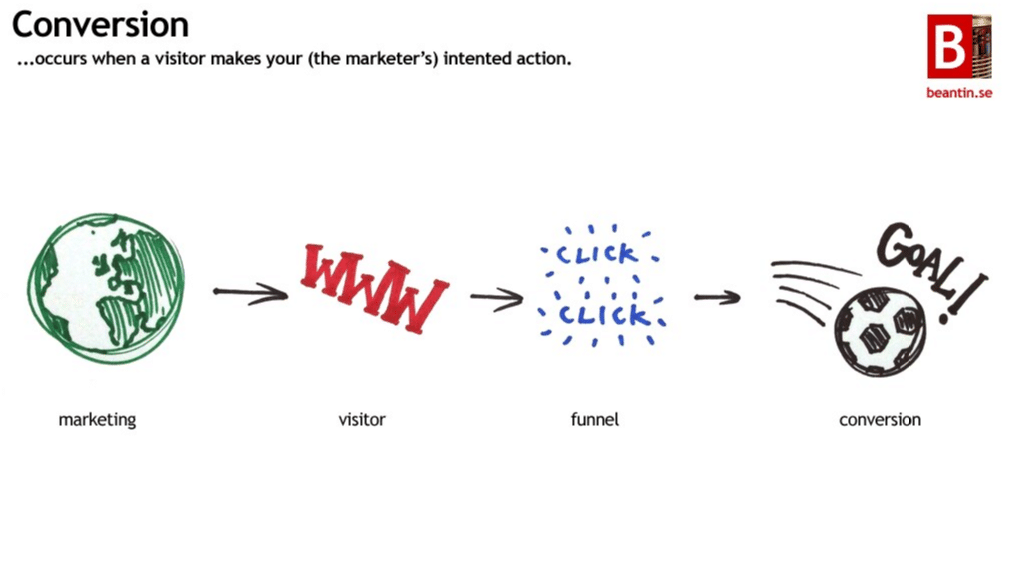You may have heard the phrase conversion marketing a number of times, especially in the digital circles. Conversion marketing is an approach that involves tailoring all of your digital marketing assets to maximize your conversion rate. But what are conversions, and how do you calculate a conversion rate? We break down the basics of a conversion marketing strategy using actual examples and tips:
What is a conversion?
Source: James Royal-Lawson on Flickr (CC BY-SA 2.0)
Conversions are actions that move a lead or customer further down the purchasing funnel. While purchases are the main conversion to aim for, actions that lead to a succesful purchase also count.
Some examples of conversions include:
- Signing up for emails
- Filling out a contact form
- Visiting certain pages on your website
- Scheduling a demo
- Starting a free trial
- Making an initial purchase
- Making a repeat purchase
- Renewing a subscription
How does a conversion marketing strategy benefit your business?
Every business dreams of having all of their leads love their product so much that they become prospects and make purchases. But as you know, conversions don’t come easily. And it usually takes time to move prospects through the buyer’s funnel (AARRR), especially if you’re a B2B.
However, more and more people are starting to learn about your products and services online. In fact, Forbes estimates that if you’re a B2B, a whopping 94% of your buyers start their journey online.
So if you can refine your most valuable “salesperson” – your website, you can effectively maximize your conversion rate and give yourself a leg up on your competitors. You’ll want to refine all other online assets that lead to your website, as well. That’s where a conversion marketing strategy comes in.
Here are other ways a conversion marketing strategy benefits your business:
Refines digital marketing processes
You’ve already invested a lot of time and energy into building your digital marketing assets, as they’re so vital for your lead generation. You repeatedly pay to maintain your website, so it would be foolish not to refine it to maximize conversions. Conversion marketing helps you tweak your digital processes to be more effective, and ultimately reduce the cost to move someone through the funnel.
Helps you improve both quantity and quality of leads
Oftentimes, you need to redesign your website to optimize for conversions. But once you’ve found out what motivates your ideal audience to convert, you’ll also enjoy a boost in lead quality. Thanks to all the data you collect, you’ll discover what types of leads complete certain conversions, and are more likely to convert.
Higher-quality leads are more likely to stick with you, so reducing your customer acquisition costs even further increases your customer lifetime value. (Tip: Starting a referral program helps you bring in quality leads because referred leads trust the recommendation of their friends!)
Increases conversion rate at every opportunity
Conversion marketing is holistic. It requires you to look at all the steps of the buyer’s journey, from when customers first get acquainted with you to when they continue making repeat purchases. The data you collect helps you find and smooth out snags in your funnel, and flag points at every funnel stage where you can improve conversions. You won’t just focus on converting new prospects, but you’ll also maximize customer retention, which is crucial to growth!
Illuminates the behaviors of your audience
What behaviors of your prospects seem to make them more likely to convert? Why do prospects get hung up at certain points? Thanks to the detailed data you’ll collect with conversion marketing, you’ll have more insight about what convinces prospects to convert, and can work toward encouraging these behaviors.
How to develop a conversion marketing strategy
Ready to learn how to develop a conversion marketing strategy?
First, you’ll need to figure out the most important, measurable steps you want leads or prospects to take that lead them to a purchase. These are your conversions, and they make up crucial points of your purchasing funnel or buyer’s journey.
All of your conversions must have a direct connection to movement through the funnel, and to increasing your bottom line. For example, the steps a B2C ecommerce store might want customers to complete could be:
- Visit the website
- Check out the store page
- Sign up for emails
- Make a first purchase
- Make a repeat purchase
On the other hand, the steps a B2B SaaS might want customers to complete could be:
- Visit website
- Visit a landing page
- Fill out a lead form
- Schedule a demo
- Start a free trial
- Purchase a plan
- Renew their plan
Once you’ve outlined the steps, it’s time to pinpoint the associated KPIs (key performance indicators) that measure the success of each conversion.
Strategize how to improve those KPIs, run regular tests, make changes, and track your progress. For example, if you’re trying to increase your number of new leads (people who fill out a lead form), track the percentage of landing page visitors who actually complete the form. This percentage is your KPI.
How can you increase this percentage? Try making changes to the landing page, based on what you think would best persuade your audience, and see if the KPI improves within a certain period of time.
Or, create an A/B test where you try two different landing page formats. Carry forward the changes from whichever page generates more conversions. Then A/B test that page again, against a page with different changes. Keep sticking with the changes that work.
Watch the KPIs of your funnel holistically to determine where to possibly smoothen it. In other words, if people aren’t making it all the way to a purchase, where in the funnel do they get stuck and why?
Make sure your call-to-actions (CTAs) are convincing, and you’ve made it easy for prospects to understand what their next steps should be.
Also, consider focusing on increasing the quality of conversions – not just the quantity. For example, you might track metrics like average order value, percentage of customers who upgrade, repeat purchases, or referred leads. It usually takes time to ramp up your conversions, but conversion marketing is well worth it.
What are some conversion marketing tactics?
Conversion marketing is a very broad term, and many tactics are likely going to be part of your conversion marketing strategy. Here are some common ones:
Lead generation: This includes any strategy meant to capture leads. Landing page optimization will usually play a huge part.
Landing page optimization: Tailoring your landing page, to encourage people to become your leads, is key in conversion marketing. Be sure to offer something of value in exchange for their contact information.
Email marketing: Once you’ve captured leads with your landing page, email marketing lets you nurture them with compelling messages. Show your leads how you can benefit them through your emails.
Reducing cart abandonment: This tactic encourages customers who have filled carts but haven’t made a purchase to return and finish the purchase. Usually, this is accomplished using pop-up prompts, discounts, and reminder emails.
Loyalty programs: These programs encourage existing customers to make repeat purchases by rewarding them with enticing perks.
Referral programs: Referral programs encourage your existing customers to refer their friends to you. These friends trust the recommendations of their peers, so they’re more likely to purchase from you. Thus, referral programs bring new, high-quality leads into the funnel.
Web page optimization: Don’t just focus on your landing pages and shop pages. Test and tweak all your webpages to smooth out the funnel and drive more conversions.
Are you part of a B2B? Do you want more insights on how to drive conversions? Check out our article on B2B lead generation strategies. And for all businesses, be sure to check out our roundup on the best ways to capture leads.





